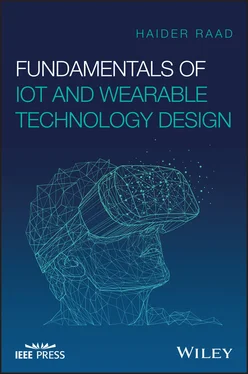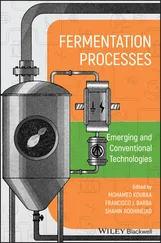1 Introduction and Historical Background
1.1 Introduction
We live in a connected world where billions of computers, tablets, smartphones, buildings, wearable gadgets, medical devices, gaming consoles, and other smart items are constantly acquiring, processing, and delivering information. In the midst of this, the topics of Internet of Things (IoT) and wearable technology have begun to enjoy tremendous popularity thanks to the rapid advancements in digital systems, communication and information technologies, and innovative manufacturing and packaging techniques.
IoT and wearable devices have managed to swiftly gain a notable position in the consumer electronics market and are now making their way to become the new go‐to technologies to address the needs of many industries. For instance, the retail industry has begun to use innovative inventory tracking and theft prevention devices based on IoT. The smart tag system enables self‐checkout and allows business owners to track and manage their inventory in real time. The construction and mining sectors are increasingly investing in the use of wearable devices for hazard and health management by monitoring the environmental quality, detecing of approaching hazards, and assessing the physiological parameters of workers. IoT‐based solutions are already being utilized in agriculture. Such systems are used to evaluate field variables such as soil condition, atmospheric parameters, and biological signals from plants and animals. They are also used to analyze and control variables such as temperature, PH levels, humidity, and vibrations, while being transported. Moreover, wearables are emerging as a solution to make healthcare accessible in remote areas (i.e. telemedicine). A plethora of wearable devices is already being used by medical professionals to aggregate physiological, behavioral, and biochemical data for diagnosing, treating, and managing chronic diseases.
IoT and wearable technology are all about enabling connectivity among humans and objects and unobtrusively delivering information and services to the right person at the right time. Their potential benefits are virtually limitless, and their applications are radically changing the way we live and are opening new opportunities for growth and innovation. This is just the tip of a massive iceberg.
This chapter presents a general overview and characteristics of IoT and wearable technology followed by a historical background; and finally, challenges that face these technologies are discussed.
1.1.1 IoT and Wearables Market Size
With around 18 billion devices connected to the Internet as of 2018, Cisco Systems predicts that this number will reach 50 billion by 2020. A recent report by the United Kingdom government speculates that this number could be even higher, in the range of 100 billion “things” connected.
A recent market analysis reports that the combined markets of IoT and wearables will grow to about $520 billion in 2021, compared to $235 billion spent in 2017. Another report indicated that the global shipments of wearables reached 49.6 million units in 2019, 55.2% up from 2018, with smart watches and wristbands continuing to dominate the wearables landscape, accounting for 63.2% of all devices shipped in that year. It is anticipated that the global wearables market share will exceed $51.50 billion by 2022.
What these numbers mean is that IoT and wearables will primarily shift the way people and businesses interact with their surroundings. Management and monitoring smart objects and systems using real‐time connectivity will enable an entirely new level of data‐driven decision making. This in turn will yield to optimized processes and deliver new services that save time and money for both people and enterprises.
1.1.2 The World of IoT and Wearables
The capability of IoT and wearable devices to communicate, process, and exchange information is the basis of their operation dynamics. These devices encompass a wide range of electronic components, sensors, actuators, computing technologies, in addition to communication and information protocols. Such technologies and protocols include but are not limited to wireless sensor networks, edge and cloud computing, big data analytics, embedded systems, security architectures, web services, and semantic search engines. However, this is also true for several other existing devices and technologies, so what makes them different?
1.1.2.1 What Is an IoT Device?
We have been connecting devices and “things” to the Internet and other networks for decades. Technologies such as automated teller machine (ATM), wireless sensor networks (WSN), machine to machine (M2M), and other connected devices are not new at all. However, this does not mean by definition that all these systems and devices are part of what we know today as the IoT. In other words, not all connected devices are IoT devices; however, all IoT devices are connected devices. Furthermore, in IoT we use the Internet Protocol (IP), IPv6, 1 in particular. Hence, we only pronounce the word Internet of Things when “things” are uniquely addressable.
There are many IoT definitions, and there isn't a universal one. It depends from which angle it is being looked at: Technology angle, application angle, or the industry angle.
However, from a general perspective IoT could be defined as the interconnection of devices with embedded sensing, actuating, and communication capabilities. Data in IoT are collected, processed, coordinated, and communicated through embedded electronics, firmware, and communication technologies, protocols, and platforms.
1.1.2.2 Characteristics of IoT Systems
We can also define the IoT as a network of connected devices, which have embedded and/or equipped with technologies that enable them to perceive, aggregate, and communicate meaningful information about the environment in which they are placed in, and/or themselves. The key characteristics of IoT from a broad‐view perspective are as follows:
Unique Identity: As mentioned above, IoT is a network of connected devices with unique identifiers. It should be noted, however, that not all IoT devices are directly connected to the Internet. It is not always possible or even desirable to do so. In fact, a good number of IoT devices in a smart home or a factory setting communicate via a non‐IP link such as ZigBee or low‐power wide‐area network (LoRaWAN), which enables these devices to communicate over distances with gateways that interface to standard IP networks. It should also be noted that when such devices use IP, it does not by default mean they are using the public Internet. There could be home and enterprise networks that use IP with data traffic that may never touch the public Internet. Also, even if there is a cluster of non‐IP devices communicating with an aggregation gateway, beyond that gateway, the expectation is that the traffic will be IP‐based. Hence, all the “nodes” of the IoT are expected to create some sort of IP traffic, whether directly, or through some gateway.
Sensing and Actuating: Sensors and actuators are two crucial elements in IoT systems. Sensors are used to perceive and gather information about some dynamic activity (pressure, temperature, altitude, etc.). The collected information is resulted from the interaction of the sensor with the environment.
A more general expression for a sensor is a transducer. A transducer is any device that converts one form of energy into another. A microphone, for instance, is a transducer that takes sound energy and converts it to electrical energy in a useful manner for other components in the system to correlate with.
An actuator is another type of transducer that is found in the majority of IoT systems. Actuators operate in the reverse manner as sensors. They typically take a form of energy and convert it into a physical action. For example, a speaker takes an electrical signal and converts it into a diaphragm vibration which replicates an audio signal.
Читать дальше












